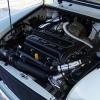Dont you want about 10 at idle?

My car idles at about 35kpa with 100kpa being ambient pressure (engine not running), which will be what (or very close).
35 at idle is pretty normal on my stock motors. With a small cam my V8 idles about mid 40's.
Timing is always a source of debate...
Right now the table is set up to represent manifold vacuum to the vacuum advance vice ported vacuum.
Using ported vacuum the source is above the throttle plate so as the throttle is opened the vacuum increases.
If the throttle is opened wide there will be no vacuum.
For manifold vacuum you have the highest vacuum draw at lower throttle settings.
Again as you stab the throttle open the vacuum will drop to nothing and you operate off mechanical advance only.
Boats and race engines do not utilize a vacuum advance simply because of the operating range od the motor. There is no light load conditions where the vacuum advance would come into play.
Both forms of vacuum advance are used on various motors.
Supposedly the manifold vacuum with the higher timing at idle is suppose to be better for emissions.
I grew up running ported vacuum so what I normally do is just just take the entire timing table from 0 to 50 map and from 0 to 800 rpm and set it to 15°.
As I noted, these tables were created strickly from the rpm and vacuum data listed in the 123 distr specs.
As I refine the actual tables I will use I will post them up.
If anyone has any other distr specs from carb models, post them up and I can build some averages and move vacuum timing around for a different look.


























